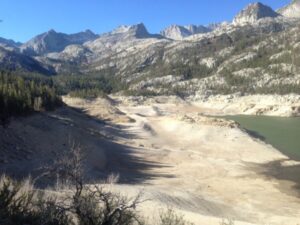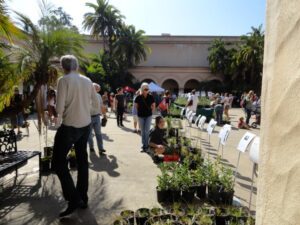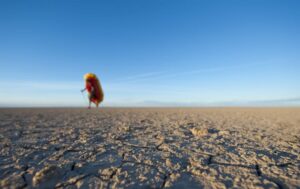For the past year, San Diego Coastkeeper, along with our environmental partners, has been advocating for smart conservation legislation at the state level. For the same amount of time, San Diego water agencies have been fighting to have conservation requirements weakened and watered down. Here’s the story of how we got to where we are now, and why forging a new, smarter relationship with water is likely now in the hands of individual San Diegans like you and local organizations like San Diego Coastkeeper.
It all started with the drought
In May 2016, when Governor Brown issued an executive order titled “Making Water Conservation a California Way of Life,” all of us at San Diego Coastkeeper felt a glimmer of hope. We have long advocated for a fundamental shift in California’s relationship with water – a move toward a wiser, less environmentally-damaging relationship with our most precious resource – and now it seemed the shift was finally upon us. With the executive order came the hope that the state was finally designing a permanent road map to ensure a smarter, more secure water future through improved conservation and efficiency.
As difficult as the relentless period of drought had been, perhaps it could serve as a necessary and long-awaited wake-up call for our state. It may have taken three years of the worst drought conditions in the state’s history, but California seemed to be changing the way we valued, talked about, and conserved water.
As some communities went without water and state water allocations halted, Californians came together and rose to the challenge this scarcity posed. We were asked to conserve, and we conserved. Month after month, most of the state was consistently exceeding the Governor’s mandatory 25 percent conservation requirement, media coverage of the drought spurred even more conservation and savings, and many businesses stepped up to innovate new technologies and practices to reduce water use in their operations and on their campuses and help to educate consumers about the importance of valuing every drop of water.
A secondary but very notable benefit of our combined water conservation efforts was enormous savings in the energy used to treat and transport water. The energy saved when Californians reduced their water use was the equivalent to taking 110,000 cars off the road – resulting in significant reductions in greenhouse gas emissions associated with moving water across the state. (You can read up on the relationship between water and energy here.)
On the heels of all this progress made by Californians – using water with more care and planting colorful natives and installing rainwater capture systems and embracing the ethos that less truly is more – a new permanent water conservation paradigm began to take shape. At the state level, legislation was introduced to help guide California beyond our current “20 percent by 2020” water conservation goals, and create a revolutionary approach to water efficiency that mirrors our state’s successful approach to energy efficiency. The drought was still in full force, but our response to it was starting to look proactive and environmentally responsible.
Reimagining our relationship with water
In the spring of 2017, as the officially declared drought emergency came to a close (if not the drought itself), 35 water agencies, associations, and NGOs came together to form an Urban Advisory Group to offer input on improved planning requirements for local water entities, and a new budget-based approach to conservation goals. This budget-based approach would allow local water entities to retain some flexibility in meeting achievable conservation and efficiency targets over time. The Urban Advisory Group helped develop a strong, consensus-based framework that yielded proposed water conservation legislation in the form of Assembly Bill 1668 and Senate Bill 606.
San Diego Coastkeeper championed both pieces of legislation. As initially written, both bills would serve to guide California toward a smarter relationship with water, and a more resilient future in the face of growing climate variability and longer, more severe periods of drought.
Forgetting the lessons of the drought


One such compromise was a ten percent “bonus” for potable recycled water, meaning that water suppliers who had potable reuse projects (like San Diego’s planned “Pure Water” program) would artificially inflate their progress toward their water efficiency target, allowing them to use – and sell – more water. We are all for potable reuse, and even have a Cooperative Agreement with the City of San Diego to further their Pure Water Program. But using projects like this as an excuse to avoid conservation is misguided and wrong. Tellingly, no water supplier seeking these bonus credits has actually shown a need for them, and since the initially-proposed water efficiency targets already incorporated local factors such that would permit increased water use in hotter, drier areas, the bonus allowance was nothing less than an excuse to needlessly waste water.
Despite locking in this allowance for waste, the City of San Diego and the San Diego County Water Authority continued to push for more exemptions and concessions – including an even bigger potable reuse credit – right up into the final days of the legislation. The benefit of all this leeway for San Diego water agencies is, of course, more money from water sales to us, their customers.
While some water suppliers remained active partners in legislative efforts, San Diego water agencies pushed to weaken efficiency standards right up until the end, touting their costly investments in desalination and recycling, and giving consumers a false sense of abundance and security that has local water use – and prices – soaring. In the end, in order to secure San Diego legislative votes, the bill authors acquiesced and included these larger allowances to waste, calling into question the integrity of the broader framework, and leaving wide open the question whether the new legislation will actually lead to conservation and efficient use in San Diego County, or maintain an unsustainable status quo.
With water use in California back to pre-drought levels and with the enormous conservation and efficiency gains made during the drought slipping away, now is not the time to reward waste. These waste-permitting bonuses send the wrong message and will limit water conservation and efficiency in our region. That’s a dangerous precedent for a region that relies on energy-intensive imported water for over 85 percent of our water supply.
Moving forward amid mixed messages


Despite this unfortunate and significant setback, and in the face of continuing attempts by San Diego water agencies to avoid participating in statewide efforts to ensure long-term efficiency, San Diego Coastkeeper will continue to closely monitor the implementation of this new legislation in our region. There are still some positive elements remaining to the legislation, including continuing public reporting requirements for water agencies, and the development of outdoor water use standards, and we are committed to seeing those implemented fully. But in the absence of meaningful conservation leadership from our local water agencies, it is going to continue to be up to individual San Diegans to cut through the mixed messaging and take the lead in converving for our region. Over our most recent drought, we proved to ourselves that we can use significantly less water without decreasing our quality of life. Ultimately, embracing a new conservation ethic that treats water with respect, highlights the natural beauty of our region, and lightens the environmental and energy impact of our appetite for water is going to be led by me and you – from the ground up.
















